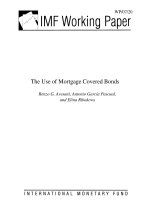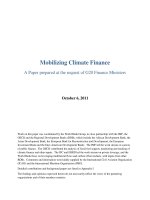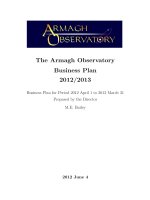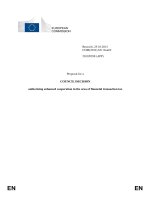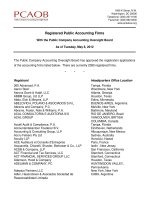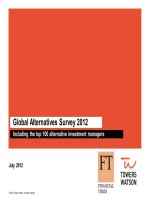The.1-2-3.Money.Plan.Oct.2010_12 pot
Bạn đang xem bản rút gọn của tài liệu. Xem và tải ngay bản đầy đủ của tài liệu tại đây (336.16 KB, 21 trang )
ptg
Chapter 7 How to Save Money . . . . . .215
213
PART III
Spending Smart Tomorrow
From the Library of Wow! eBook
ptg
This page intentionally left blank
From the Library of Wow! eBook
ptg
A
s I talked about in Chapter 2, “First Things
First,” goals give you direction and can provide
peace of mind. They even have application in
daily life. With all the marketing bombarding us every
day and fueling our wants, a set of goals helps us to say
no. They remind us there’s something we want more
than the tempting purchase right in front of us.
Even when you have written savings goals, it takes a
lot of willpower to consciously stash away money each
month. We humans are hardwired to consume immedi-
ately. So, saving for future needs and wants goes against
our nature.
That’s why saving toward goals must be automatic.
It could be an automatic 401(k) deduction from your
paycheck to fund retirement or an automatic draft from
your checking account that adds to your “snorkeling in
Bahamas fund.”
You put money toward priorities first, and then
you’re free to spend what’s left on daily living. In that
215
Chapter 7
How to Save Money
From the Library of Wow! eBook
ptg
way, having goals is freeing. You don’t have to be con-
stantly wondering if you’re doing all the right savings
things and feeling guilty about indulging in small daily
purchases.
You might have heard this called “Pay yourself first”
because you stash away money for your goals before
paying everybody else. It’s also an alternative to a full-
fledged household budget. By saving first, you create an
artificial environment of money scarcity in the house-
hold. It erects boundaries to our spending. Specifically,
it cuts down on the cash we have around, so we don’t
spend as much. It’s based on the idea that we’ll spend all
that’s available to us unless there’s a darned good rea-
son not to. This is why increasing your retirement con-
tribution is relatively painless. It’s true, you’ll have less
money to spend each week, but you unconsciously
adjust your spending accordingly. Unless it’s a huge
jump in savings, you won’t even notice the difference.
Automatic savings leads automatically to lower
spending.
Erecting these artificial boundaries for money is use-
ful. In America, we get very used to abundance and
“unlimited.” Do you remember when we used to pay
for a certain number of hours each month for Internet
access? Now, most Internet access is unlimited. We used
to pay by the minute for long-distance phone calls.
Today, many calling plans include unlimited long
distance.
For decades, gasoline seemed unlimited because no
matter how much we used, the price was always about
$1.25 per gallon. Of course, it only seemed unlimited,
216
The 1-2-3 Money Plan
From the Library of Wow! eBook
ptg
as we found out in recent years, as demand grew and
prices fluctuated wildly.
Diamonds aren’t rare, and aren’t intrinsically valu-
able. They only cost a lot because diamond companies
restrict the supply and constantly advertise that dia-
monds are special. And somehow they became a
mandatory element of marriage proposals. Producers of
diamonds create an artificial environment of scarcity.
You can do the same thing with your household
finances.
Of course, the big problem with the artificial scarcity
plan is the availability of credit. Whether credit cards or
a home-equity line of credit, that ability to borrow
money easily removes the scarcity boundaries you arti-
ficially set up. It makes no sense to pay yourself first and
save money earning 3 percent interest but exceed your
boundaries by spending on credit cards and pay 18 or
29 percent interest. So, to use the artificial scarcity plan,
you must not borrow money for consumer purchases.
It’s like being on a diet and throwing away all the
cookies and potato chips, creating a scarcity of junk
food in the kitchen. The only thing to eat is healthful
stuff, so you do. But such a diet plan is doomed if you
regularly stop by the convenience store for donuts and
Doritos, in effect sidestepping the scarcity boundaries
you artificially set up. (In case you got lost with that
analogy, credit cards are the convenience-store Doritos.)
In the end, paying yourself first is voluntary self-
deception, like setting your clock ahead 10 minutes so
you won’t be late. If you are committed to the decep-
tion, it works great.
217
How to Save Money
From the Library of Wow! eBook
ptg
Short-Term Savings
Don’t be shy about opening separate bank accounts for
each of your short-term goals. Of course, you want
accounts that won’t charge you any fees. It’s true that
opening more accounts slightly complicates things
because you have more accounts to keep track of. But
it’s well worth it because you’ll be very clear about what
your short-term spending goals are and how you’re
funding them. It’s similar to the simple envelope system
for daily spending, with one envelope containing money
for food, another for clothing, and so on.
218
The 1-2-3 Money Plan
Short-Term Savings, 1-2-3
1. Emergency fund.
2. Car fund.
3. Seasonal fund.
If you’re going to be stashing cash in separate
accounts, it would be nice to earn a little interest on the
money. That’s why an online savings account is a great
choice. For years, among the best choices for online sav-
ings accounts have been:
● EmigrantDirect.com
● INGDirect.com
● HSBCdirect.com
Frankly, it doesn’t matter much which one you
choose. Go with whichever account happens to be pay-
ing a higher interest rate than the others at the time you
From the Library of Wow! eBook
ptg
look at them. Rates change often, but historically, they
have been in the same narrow range. You’ll drive your-
self crazy always trying to get the absolute highest inter-
est rate. Remember the concept of “good enough?”
Deposits at all three banks are insured by the Federal
Deposit Insurance Corp. (FDIC), up to $100,000
1
per
depositor. And they are all good enough.
Opening an online account is fairly easy. Follow
instructions on the Web sites, and fill out forms. You
will have to electronically link a personal checking
account to the savings account to make automatic
deposits. You will also have to provide your Social
Security number.
1. Emergency Fund
Whether you call it a rainy-day fund, an emergency
fund, or a cash cushion, having cash available for when
bad things happen is fundamental to financial planning.
What exactly constitutes an emergency fund? The
typical advice is also the most conservative definition:
cash equal to three to six months of living expenses. I
would modify that to be three to six months of “bare-
bones” expenses, meaning enough money to pay rent or
mortgage, food, utilities, transportation, insurance, and
so on.
Why? Because in a financial crisis—think, losing
your job—you should immediately cut back on
nonessential spending—no going out to eat, no clothing
purchases, and no golfing. You could even start cancel-
ing your gym membership, your cable TV service, and
your fancy hairdresser appointment. The point is you
219
How to Save Money
From the Library of Wow! eBook
ptg
need a cushion to pay for necessary expenses, a total far
less than expenses during flush times.
How do you decide on whether to save three months
of expenses or six? It depends on your circumstances.
For example, two-income families have less of a need
for a large emergency fund, especially if both earners
make about the same amount of money. That’s because
a job loss, among the most serious of emergencies, does-
n’t wipe out the entire household income. A one-income
family needs a larger contingency fund. The size of the
emergency fund can also depend on your financial com-
mitments. People with a paid-off house and no car pay-
ments might get by with a smaller cushion. This, by the
way, is yet another reason to keep debt at a minimum.
Why have an emergency fund? We talked about the
most serious scenario, having cash to live on if you lose
your job. Other reasons include life’s expected-but-
unexpected cash drains. We don’t know when they’re
coming but cash outlays for such expenses as car
repairs, medical bills, and plumbing leaks are coming
sooner or later. Without the cash to pay for these,
you’re likely to put them on a credit card and rack up
finance charges. That just makes those “emergencies”
more expensive.
Other reasons to have an emergency fund are less
obvious. It can actually save you money. Think about it:
With a cash cushion, you can feel comfortable saying no
when a salesperson offers you an extended warranty.
Why? Because you have the money to pay for the
repairs if the item breaks. You can call your insurance
agent and raise deductibles on your home and auto
insurance, which will save you money on premiums.
220
The 1-2-3 Money Plan
From the Library of Wow! eBook
ptg
Why? Because you have the cash to pay a higher
deductible if you file a claim.
Maybe an emergency fund’s greatest value is provid-
ing peace of mind, which any financially stressed-out
person will tell you has a real dollar value.
Creating a rainy-day fund can be a two-step process.
Although the long-term goal is a fund equal to three to
six months’ worth of bare-bones living expenses, a
shorter-term goal might be to stash away $2,500. At
that point, you haven’t protected against job loss, but
you have given yourself financial breathing room when
the car and the clothes washer break down at the same
time. Make the $2,500 emergency fund a high-priority
goal. Fully funding the cash cushion can be balanced
among your other financial priorities. For example, it
would take a backseat to paying off high-interest debt.
That’s especially true if you take a few steps to grow
your emergency fund through noncash means. A cash
horde is ideal, but in a crisis you simply need quick
access to money, whether it’s your own or someone
else’s.
Here are a few temporary moves to make in lieu of
a fully funded emergency fund. These are in addition to
your $2,500 in cash:
● Establish a home-equity line of credit.
Homeowners could count home equity as part of
their temporary emergency fund. A home-equity
line is an open credit line against the equity you
have built up in your house. It’s cheap or free to
open a line of credit, and you pay no interest
unless you use it. If you use it, the interest you pay
221
How to Save Money
From the Library of Wow! eBook
ptg
is likely to be tax deductible. With most HELOC
accounts, you tap the line of credit by writing
checks on the account or using a debit card to
access the credit line. Apply for an equity line
before a crisis occurs. Once disaster hits—you lose
your job, for example—you might not qualify to
open a HELOC. All that said, however, a home-
equity line is not a good choice for compulsive
spenders who will use the credit line for nonemer-
gencies. And lenders have tightened requirements
for getting a HELOC since the 2008 financial cri-
sis. Improving your credit score will increase the
chances of being approved for an equity line.
● Raise your credit card limits. Using high-interest
credit cards is a very common but lousy way to
address a financial emergency. If you’re responsi-
ble with credit cards and rarely carry a balance,
however, it couldn’t hurt to ask your card com-
pany to raise your limits if you do it the right way.
You must ask them to raise your maximum charge
limit “without pulling my credit report.” That
way, the request will not damage your credit rat-
ing, as I said in Chapter 6, “Credit When Credit’s
Due.” In fact, it could help your credit rating if
you’re successful because part of the credit score is
based on the amount of used credit compared
with the amount of available credit. A second
advantage is the higher limit gives you a source of
cash during a temporary cash-flow jam. There are
more details about your credit cards in Chapter 6.
Once you’re already in a money crisis with no emer-
gency fund to tap, more desperate measures might be
necessary. None of these options is an ideal solution:
222
The 1-2-3 Money Plan
From the Library of Wow! eBook
ptg
● Consider nonretirement investments. Your regular
investments outside of retirement plans might be
mostly held in volatile stocks or in accounts that
might charge an early withdrawal penalty, but
these can be sources of emergency cash. True,
using these funds in an emergency might force you
to take an investment loss, but addressing a true
crisis is usually more important.
● Evaluate the bank of mom and dad. Borrowing
from relatives or friends is dicey at best, and
should probably be among the last resorts in a cri-
sis because it has ruined many relationships. But
it could be a source of emergency money. One idea
is to formalize such a loan by writing down the
terms. Consider using loan documents from a
place such as LawDepot.com or using a com-
pany such as CircleLending.com to formalize the
paperwork.
● Borrow or withdraw from a 401(k). I hesitate to
mention this option because unless you’re desper-
ate, it’s a really bad idea. But you can borrow and
withdraw from a 401(k) retirement account.
There can be huge tax penalties and you’ll lose
growth on the money, which was supposed to go
toward retirement. In the case of borrowing,
you’ll withdraw pretax money and pay yourself
back with interest by using after-tax money. Then
in retirement, you’re taxed on withdrawals. So,
you’re being double-taxed on that money. Review
with your plan administrator all the disadvantages
of loans and withdrawals before going ahead. All
that said, it is a source of cash if you’re desperate.
But consider this my attempt to nudge you away
from this option.
223
How to Save Money
From the Library of Wow! eBook
ptg
In short, you need a rainy-day fund and a plan to
access cash in a financial storm. It will, indeed, rain. It’s
just a matter of when.
2. Car Fund
Just like you will have financial emergencies, you will
replace your vehicle. It’s just a matter of when. Maybe
no purchase gets consumers in more trouble than buy-
ing a car or truck. It’s a two-headed problem.
First, people lust after cars they can’t afford, which
leads to five-year loans or longer and ridiculous leases
(which is redundant because almost all leases are a
ridiculous choice for people concerned with spending
money smarter). People concentrate too much on the
monthly payment, instead of how the purchase fits into
their financial life. For the record, I’m obligated by all
that’s good and true in personal finance to urge you
once again to buy a slightly used vehicle. That way, you
avoid much of the new-car depreciation.
The second big mistake many people make is not
putting down much money when buying a vehicle—or
worse, rolling the payment of a previous vehicle into the
loan on a new one. This leads to the brutal situation of
actually owing more on a car than it’s worth, or being
“upside down.” You can’t sell the vehicle—or, if you get
in a bad accident, you can’t total the car—without los-
ing thousands of dollars.
I don’t want to get all ridiculous on you, but what if
you paid cash for your next vehicle? In fact, I would
argue that if you can’t pay cash for a vehicle, you can’t
afford it.
224
The 1-2-3 Money Plan
From the Library of Wow! eBook
ptg
Here’s how to pay cash for your next vehicle: After
you pay off your current vehicle, continue making the
same monthly payment to yourself. Do that by making
an automatic payment to a separate car-fund account.
Then when you go to replace your vehicle, you’ll have
the trade-in value, plus cash saved in this account. That
total becomes the purchase price of your new car, which
you can now buy for cash. At the very least, you’ll have
a sizable down payment.
Here’s just one example of how it would work: Keep
your vehicle for four years after paying it off. If you
were paying $400 a month, you would accumulate
$19,200, plus interest, in your car fund. For simplicity,
let’s call it 20 grand. This, by the way, requires no addi-
tional sacrifice on your part. You’ve already been pay-
ing this $400 a month for several years.
If you get $5,000 by selling or trading in your old
car, you can now pay $25,000 for a lightly used luxury
car of your choosing.
How cool is that?
3. Seasonal Fund
This is an intentionally vague account. Customize it to
fit short-term savings goals in your life. For example,
you could use it for three major seasonal expenses,
which happen to be spaced apart on the calendar. That
means you can fund and deplete the account continually
throughout the year. These seasonal expenses are as
follows:
● Holiday spending. Gifts, travel, decorations,
parties
225
How to Save Money
From the Library of Wow! eBook
ptg
● Spring vacation. Airfare, hotel, car rental
● Back-to-school. Clothing, school supplies, tuition,
computers, textbooks
Another good idea is to have a separate account
when you’re saving for a house down payment. If you
already own a house, you might create an account for
home improvements, whether that’s new siding, new
furniture, or a kitchen remodel.
The running theme with any of these short-term sav-
ings accounts is to fund them regularly and automatically.
That way, you’ll have no trouble achieving those goals.
Retirement
Retirement investing for individuals is relatively new. A
generation ago, most people had defined pensions,
which meant that when you retired, you got a check
every month. It was someone else’s job to invest that
money. Today, you’re responsible, like it or not.
226
The 1-2-3 Money Plan
Retirement, 1-2-3
1. Invest automatically. Invest 10 percent of
your income into a retirement plan, such as a
401(k) or Roth IRA.
2. Diversify. Invest all the money in a target-
date retirement fund closest to when you’ll
retire.
3. Hold on. Never touch the money until you
retire.
From the Library of Wow! eBook
ptg
“Come on,” you’re thinking. “Entire books are writ-
ten on retirement investing. How can it be this simple?”
It can. For the vast majority of people, this simple
plan will work wonderfully. It’s “good enough” to
ensure you’re saving for a respectable retirement. Of
course, you can tweak this simple plan along the way,
and probably should. But not doing these steps, or ones
very similar, could mean you’re in for a rough time in
your golden years.
Just because it’s simple, doesn’t mean it’s unsophisti-
cated. And it certainly doesn’t mean it’s inferior. In fact,
with investing, the more complicated things get, the
more likely you’ll be railroaded and some money man-
ager is going to get rich off you.
Getting started with retirement saving is as easy as
visiting your human resources department at work or
going online to sign up for a retirement plan. If you
started a new job, your employer might have enrolled
you automatically. If you already have a retirement plan
started, you can still use these steps by modifying your
contributions and allocations.
How big of a retirement nest egg do you need to
build? Whatever number you come up with is simulta-
neously supremely important and utterly meaningless.
You could assume you’ll spend the same amount of
money you do now, adjusted for inflation. But how rea-
sonable is that, especially if you’re in the wildly expen-
sive raising-a-family stage of life?
Expenses in retirement often decrease. For example,
you won’t be funneling money into a retirement plan,
child expenses are gone, and perhaps you paid off the
227
How to Save Money
From the Library of Wow! eBook
ptg
home mortgage. On the other hand, you might need
more money for traveling, recreation, and medical care.
Online calculators are a help in determining what
you need because the math is complicated to do by hand.
The more detailed—and unfortunately, tedious—the
online questionnaire, the better your estimate will be.
Examples of online calculators include the following:
● www.Fidelity.com/myPlan
● www3.troweprice.com/ric/RIC
● www.dinkytown.net
● www.choosetosave.org/ballpark
● www.aarp.org
Financial software, such as Quicken, also has retire-
ment tools.
But realize that any dollar figure you come up with
is just an educated guess. The best professional financial
planners can only speculate about what the total dollar
figure for your nest egg should be and what you need to
be saving along the way to accumulate that dollar fig-
ure. That’s because of the unknowable assumptions.
These include everything from how long you’ll live, to
inflation rates, to what return your investments will
earn. But an informed estimate is far better than none at
all. It will give you a ballpark figure, so you know
you’re striving for either $750,000 in retirement savings
or $4 million.
Focus on what you can control; that is, stashing
away money automatically, keeping it diversified, and
keeping your hands off it. The retirement goal might
seem like an absurdly large number. But the only way to
eat an elephant is one bite at a time.
228
The 1-2-3 Money Plan
From the Library of Wow! eBook
ptg
1. Invest Automatically
As discussed previously, making retirement contribu-
tions automatic is fundamentally important. Employer
retirement plans are great because the money disappears
from your paycheck before you get it. The other good
way is to fund a retirement account with automatic
monthly transfers from your checking account.
Here are some basic questions and answers about
investing for retirement:
● Why should I save for retirement? Because you’ll
reach an age where you don’t want to work any-
more, or physically (or mentally) can’t. If you
don’t have savings earmarked for your retirement
years, you’ll be destitute or a burden to family
members who will have to care for you.
● Why make it automatic? Retirement sounds like a
long way off for many people. That makes it
extremely difficult to make it a priority when the
bustle of everyday life puts numerous demands on
our money. With most people, if they have to
write a check every month to their retirement
plan, life will get in the way and they’ll skip some
months, or many months. But if you make it auto-
matic, by contributing through a regular paycheck
deduction or a regular draft from your checking
account, you’re more likely to succeed in saving
regularly.
● Why invest at least 10 percent? Besides being a
nice, round, easy-to-remember number, it’s
enough to start you on the path toward building
retirement wealth. It also works well with the typ-
ical 401(k) plan, in which an employer matches
229
How to Save Money
From the Library of Wow! eBook
ptg
the first 6 percent of whatever you contribute.
You’ll be guaranteed to capture all of that free
money. And 10 percent is a good start toward 15
percent, a contribution goal many financial advis-
ers suggest.
230
The 1-2-3 Money Plan
QUICK TIP
One painless way to get to 15 percent is to raise your
contributions by 1 percent or 2 percent every time you
get a pay raise. That way, you won’t notice a reduc-
tion in your take-home pay.
● Why use a retirement plan? You could just squir-
rel away money in regular mutual funds for retire-
ment. But when you use the umbrella of a
retirement plan, you can shield the money from
taxes, either now or later. If you pay less tax,
you’ll have more money in retirement.
● Which retirement savings vehicle should I use?
This is where many people get bogged down.
First, know that it’s less important which retire-
ment plan you choose. It’s more important that
you automatically contribute to a retirement
plan—any retirement plan. That said, the follow-
ing are brief descriptions of some of your choices:
● 401(k) and 403(b). If you qualify for a 401(k)
retirement plan at work that matches your con-
tributions, join the plan and contribute 10 per-
cent of your income. This is the easiest solution.
The 403(b) and 457 plans are similar. These
plans have such complicated-looking names
because they refer to part of the federal tax
From the Library of Wow! eBook
ptg
code. Considering it involves the IRS, what else
would it be except complicated?
A 401(k) allows retirement money to grow tax
free. The pain of contributing is reduced because
less tax money will be deducted from your pay-
check. So, contributing $100 to your 401(k)
reduces your net pay by less than $100. The
exact amount depends on your income-tax
bracket and several other factors. With a
401(k), Uncle Sam gets his cut when you with-
draw the money in retirement. It will be taxed at
your regular income tax rate, whatever it is at
that time.
231
How to Save Money
QUICK TIP
If your employer matches your contributions, don’t
miss out on that free money! I’ve alluded to this previ-
ously, but it’s worth emphasizing. Often an employer
will contribute 3 percent of your pay if you contribute
6 percent. This is a fantastic deal. That’s a 50 percent
guaranteed return on your money. You can’t get that
anywhere else. Even if you dislike your employer plan,
contribute at least enough to get the full matching
contribution.
● Roth IRA. For those who don’t have a 401(k) at
work, open a Roth IRA and sign up to make
regular contributions. With a Roth, you con-
tribute money but get no up-front tax break.
The benefit comes when you retire. That’s when
you can withdraw all the investment earnings
contributed over the years, tax free. That’s a
From the Library of Wow! eBook
ptg
huge advantage. The downsides are that higher-
income people don’t qualify to use a Roth and,
if you do qualify, you can’t stash away a ton of
money—$5,000 a year in 2009 ($6,000 if you’re
age 50 or older). The earnings limits in 2009
were $120,000 if you’re single and $176,000 if
you’re married. If your so-called “modified
adjusted gross income,” a line on your tax form,
is larger than those limits, you can’t use a Roth.
And if your income is close to those limits, you
might be allowed to make only a partial contri-
bution of somewhat less than $5,000. Find
updated limits and how to calculate modified
adjusted gross income in IRS publication 590 at
IRS.gov.
You can open a Roth IRA with many investment
companies. Look for a place where you can
make automatic contributions and one that has
target-date retirement funds (more on that next,
when we talk about diversifying your invest-
ments). You’ll do well if you first check out
Vanguard at www.vanguard.com, T. Rowe Price
at www.troweprice.com, and Fidelity at
www.fidelity.com.
Again, there are many ways to open a Roth
IRA, including using a planner or broker and
using a different family of mutual funds. But
they probably will be more expensive because of
broker commission and funds with high, built-in
expenses.
232
The 1-2-3 Money Plan
From the Library of Wow! eBook
ptg
● What if I’m self-employed? If you’re self-
employed, you probably have an accountant—or
you should. Unless you’ll make a hobby out of
poring over income-tax strategies, taxes are often
overly complicated for busy business owners. So,
when it comes to investing for retirement, seek
advice from your accountant. He or she will
explain such retirement options as the individual
401(k), the SEP, and the SIMPLE IRA.
2. Diversify
So, once you have decided on a retirement account and
resolved to invest automatically, which individual
investments should you choose? You’ve probably heard,
“Don’t put all your eggs in one basket.” You might have
heard of “diversification.” They both mean the same
thing—spread your money around to different types of
investments. Good diversification has been shown to
reduce volatility and improve investment returns over
time.
Again, this is where people get bogged down and
confused. So, here’s some simple advice that will be
more than “good enough” for most people:
Put all your retirement money in a “target-date”
fund closest to when you’ll retire.
That’s it, you’re done.
“No way. It can’t be that easy,” you’re thinking.
“Yes way. It can,” I say.
Let’s back up and talk about these “target-date”
funds, sometimes called lifestyle funds. You’ve heard
233
How to Save Money
From the Library of Wow! eBook


